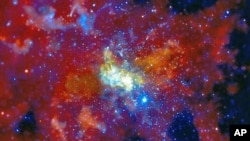A new theory proposes that mysterious dust clouds that obscure the supermassive black holes sitting at the center of most galaxies are the pulverized debris of high-speed collisions between nearby planets and asteroids.
Scientists at Britain’s Leicester University suggest the powerful cosmic crashes generate such tremendous energy that microscopic dust grains are all that eventually remain of the two colliding objects. They estimate the collisions occur at speeds of up to 1,000 kilometers per second.
About one half of the supermassive black holes observed are shrouded by a puzzling cloud of dust. The new theory to explain the phenomenon is based on the idea that the inner region of a galaxy has stars, planets and asteroids, as well as a supermassive black hole.
The study's lead author, Sergei Nayakshin, said the collisions and the high levels of intense radiation would make it doubtful there would be life on any planet orbiting a supermassive black hole.
The researchers say that unlocking the origin of the dust clouds helps to provide new clues about the enigmatic nature of supermassive black holes, including the one lying dormant at the center of our own Milky Way galaxy.
Inspiration for the work was drawn from scientific observations of collisions between asteroids and comets in our own solar system.
The new study is published in the journal of the British Royal Astronomical Society.
Nothing - not even light - can escape from a black hole. The dense mass of a supermassive black hole is millions of times greater than that of our Sun. Its powerful gravitational forces can capture anything from subatomic particles to stars, which are pulled apart and swirled into its void at nearly light-speed.
Planet Collisions May Create Mysterious Dust Clouds








